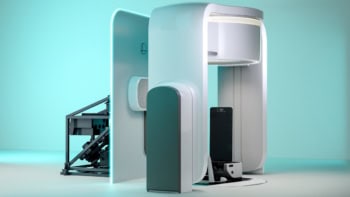
Sonodynamic therapy (SDT) is a promising, non-invasive cancer treatment that uses ultrasound to activate sonosensitizers, which in turn generate reactive oxygen species (ROS) that attack and destroy tumour cells. Researchers from Soochow University in China have developed a new type of sonosensitizer that enhances the amount of damage than SDT can inflict upon tumours without harming normal tissue. Writing in Applied Physics Reviews, they describe how the new sonosensitizer can suppress the growth of human breast cancer tumour cells in mice.
The new sonosensitizer is based on vanadium-doped titanium dioxide (V-TiO2) nanospindles. While TiO2 has been used in the past as a sensitizer, it does not work well because it has a wide band gap in its electronic structure. This causes electrons stripped away by ultrasound to rapidly recombine with the nanoparticles, preventing the generation of ROS. The researchers determined that if they doped the TiO2 nanoparticles with vanadium to form nano-sized spindles, this would reduce the band gap, thus increasing the efficiency of ultrasound-triggered ROS production.
Lead author Xianwen Wang and colleagues also determined that vanadium doping causes the nanospindles to act like tiny enzymes that catalyse the generation of highly toxic hydroxyl radicals from hydrogen peroxide contained within the tumour. This provides an additional method of killing the cancer cells, via chemodynamic therapy. Additionally, they report that the nanospindles cause glutathione depletion, which further increases the oxidative stress generated by the chemodynamic–sonodynamic therapy.
The researchers created high-quality V-TiO2 nanospindles and then coated them with polyethylene glycol to create V-TiO2-PEG nanospindles with good water solubility. Following initial testing, they assessed the cytotoxicity of the nanospindles using both non-cancerous human umbilical endothelial vein cells and breast cancer cells. They confirmed that the V-TiO2-PEG nanospindles exhibited no obvious cytotoxicity to the non-cancerous cells but that the viability of the cancerous cells decreased with increasing nanospindle concentration.
The team next examined the therapeutic efficacy of the nanospindles in the cancer cells and in vivo in tumour-bearing mice. The mice were divided into five groups, which received: no treatment (control group); ultrasound irradiation; injection of V-TiO2-PEG nanospindles; injection of commercial TiO2 nanoparticles plus ultrasound; and injection of V-TiO2-PEG nanospindles plus ultrasound.
Tumours in the control group grew rapidly, while the nanospindle-only and the ultrasound-only groups experienced moderate tumour growth suppression. Tumour growth in mice receiving nanoparticles/nanospindles plus ultrasound was markedly suppressed, with the most severe tumour damage and necrosis seen in animals receiving V-TiO2-PEG nanospindles plus ultrasound. ROS staining revealed that tumour sections in this latter group exhibited the strongest fluorescence, indicating that V-TiO2-PEG nanospindles plus ultrasound irradiation generated more ROS in tumour tissues than nanospindles or ultrasound alone.
The researchers identified V-TiO2-PEG nanospindles in the spleen and liver of the mice and, later, in the animals’ faeces and urine. They did not detect any obvious signs of organ inflammation or damage. “It is worth noting that the V-TiO2 nanospindles are rapidly excreted from the body,” comments co-author Liang Cheng. “This helps prevent any possible long-term toxicity effects.”
“Our all-in-one nano-platform based on V-TiO2 nanospindles with tumour microenvironment modulating properties enhances sonodynamic therapy against cancer,” conclude the researchers.



